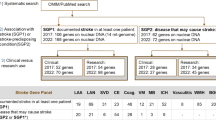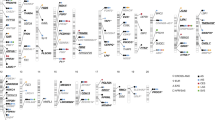Abstract
We previously mapped susceptibility to stroke to chromosome 5q12. Here we finely mapped this locus and tested it for association with stroke. We found the strongest association in the gene encoding phosphodiesterase 4D (PDE4D), especially for carotid and cardiogenic stroke, the forms of stroke related to atherosclerosis. Notably, we found that haplotypes can be classified into three distinct groups: wild-type, at-risk and protective. We also observed a substantial disregulation of multiple PDE4D isoforms in affected individuals. We propose that PDE4D is involved in the pathogenesis of stroke, possibly through atherosclerosis, which is the primary pathological process underlying ischemic stroke.
This is a preview of subscription content, access via your institution
Access options
Subscribe to this journal
Receive 12 print issues and online access
$209.00 per year
only $17.42 per issue
Buy this article
- Purchase on Springer Link
- Instant access to full article PDF
Prices may be subject to local taxes which are calculated during checkout




Similar content being viewed by others
References
Sacco, R.L. et al. American Heart Association Prevention Conference. IV. Prevention and Rehabilitation of Stroke. Risk factors. Stroke 28, 1507–1517 (1997).
Bonita, R. Epidemiology of stroke. Lancet 339, 342–344 (1992).
Caplan, L.R. Caplan's Stroke: A Clinical Approach. (Butterworth-Heinemann, Boston, 2000).
Adams, H.P. Jr. et al. Classification of subtype of acute ischemic stroke. Definitions for use in a multicenter clinical trial. TOAST. Trial of Org 10172 in Acute Stroke Treatment. Stroke 24, 35–41 (1993).
Fisher, C.M. Lacunar strokes and infarcts: a review. Neurology 32, 871–876 (1982).
Alberts, M.J. Genetics of Cerebrovascular Disease (Futura, New York, 1999).
Hassan, A. & Markus, H.S. Genetics and ischaemic stroke. Brain 123, 1784–1812 (2000).
Leys, D. et al. Stroke prevention: management of modifiable vascular risk factors. J. Neurol. 249, 507–517 (2002).
Brass, L.M. & Alberts, M.J. The genetics of cerebrovascular disease. Baillieres Clin. Neurol. 4, 221–245 (1995).
Tournier-Lasserve, E. et al. Cerebral autosomal dominant arteriopathy with subcortical infarcts and leukoencephalopathy maps to chromosome 19q12. Nat. Genet. 3, 256–259 (1993).
Joutel, A. et al. Notch3 mutations in CADASIL, a hereditary adult-onset condition causing stroke and dementia. Nature 383, 707–710 (1996).
Palsdottir, A. et al. Mutation in cystatin C gene causes hereditary brain haemorrhage. Lancet 2, 603–604 (1988).
Levy, E. et al. Mutation of the Alzheimer's disease amyloid gene in hereditary cerebral hemorrhage, Dutch type. Science 248, 1124–1126 (1990).
Gunel, M., Awad, I.A., Anson, J. & Lifton, R.P. Mapping a gene causing cerebral cavernous malformation to 7q11.2–q21. Proc. Natl. Acad. Sci. USA 92, 6620–6624 (1995).
Laberge-le Couteulx, S. et al. Truncating mutations in CCM1, encoding KRIT1, cause hereditary cavernous angiomas. Nat. Genet. 23, 189–193 (1999).
Sahoo, T. et al. Mutations in the gene encoding KRIT1, a Krev-1/rap1a binding protein, cause cerebral cavernous malformations (CCM1). Hum. Mol. Genet. 8, 2325–2333 (1999).
Gretarsdottir, S. et al. Localization of a susceptibility gene for common forms of stroke to 5q12. Am. J. Hum. Genet. 70, 593–603 (2002).
Terwilliger, J.D. & Ott, J. A haplotype-based 'haplotype relative risk' approach to detecting allelic associations. Hum. Hered. 42, 337–346 (1992).
Falk, C.T. & Rubinstein, P. Haplotype relative risks: an easy reliable way to construct a proper control sample for risk calculations. Ann. Hum. Genet. 51 (Pt 3), 227–233 (1987).
Houslay, M.D. & Adams, D.R. PDE4 cAMP phosphodiesterases: modular enzymes that orchestrate signalling cross-talk, desensitization and compartmentalization. Biochem. J. 370, 1–18 (2003).
Liu, H. & Maurice, D.H. Phosphorylation-mediated activation and translocation of the cyclic AMP- specific phosphodiesterase PDE4D3 by cyclic AMP-dependent protein kinase and mitogen-activated protein kinases. A potential mechanism allowing for the coordinated regulation of PDE4D activity and targeting. J. Biol. Chem. 274, 10557–10565 (1999).
Liu, H. et al. Expression of phosphodiesterase 4D (PDE4D) is regulated by both the cyclic AMP-dependent protein kinase and mitogen-activated protein kinase signaling pathways. A potential mechanism allowing for the coordinated regulation of PDE4D activity and expression in cells. J. Biol. Chem. 275, 26615–26624 (2000).
Baillie, G., MacKenzie, S.J. & Houslay, M.D. Phorbol 12-myristate 13-acetate triggers the protein kinase A-mediated phosphorylation and activation of the PDE4D5 cAMP phosphodiesterase in human aortic smooth muscle cells through a route involving extracellular signal regulated kinase (ERK). Mol. Pharmacol. 60, 1100–1111 (2001).
Jin, S.L. & Conti, M. Induction of the cyclic nucleotide phosphodiesterase PDE4B is essential for LPS-activated TNF-α responses. Proc. Natl. Acad. Sci. USA 99, 7628–7633 (2002).
Landells, L.J. et al. Identification and quantification of phosphodiesterase 4 subtypes in CD4 and CD8 lymphocytes from healthy and asthmatic subjects. Br. J. Pharmacol. 133, 722–729 (2001).
Fukumoto, S. et al. Distinct role of cAMP and cGMP in the cell cycle control of vascular smooth muscle cells: cGMP delays cell cycle transition through suppression of cyclin D1 and cyclin-dependent kinase 4 activation. Circ. Res. 85, 985–991 (1999).
Ogawa, S. et al. Hypoxia-induced increased permeability of endothelial monolayers occurs through lowering of cellular cAMP levels. Am. J. Physiol. 262, C546–C554 (1992).
Stelzner, T.J., Weil, J.V. & O'Brien, R.F. Role of cyclic adenosine monophosphate in the induction of endothelial barrier properties. J. Cell Physiol. 139, 157–166 (1989).
Pan, X., Arauz, E., Krzanowski, J.J., Fitzpatrick, D.F. & Polson, J.B. Synergistic interactions between selective pharmacological inhibitors of phosphodiesterase isozyme families PDE III and PDE IV to attenuate proliferation of rat vascular smooth muscle cells. Biochem. Pharmacol. 48, 827–835 (1994).
Palmer, D., Tsoi, K. & Maurice, D.H. Synergistic inhibition of vascular smooth muscle cell migration by phosphodiesterase 3 and phosphodiesterase 4 inhibitors. Circ. Res. 82, 852–861 (1998).
Indolfi, C. et al. Activation of cAMP-PKA signaling in vivo inhibits smooth muscle cell proliferation induced by vascular injury. Nat. Med. 3, 775–779 (1997).
Indolfi, C. et al. 8-chloro-cAMP inhibits smooth muscle cell proliferation in vitro and neointima formation induced by balloon injury in vivo. J. Am. Coll. Cardiol. 36, 288–293 (2000).
Tilley, S.L., Coffman, T.M. & Koller, B.H. Mixed messages: modulation of inflammation and immune responses by prostaglandins and thromboxanes. J. Clin. Invest. 108, 15–23 (2001).
Vicini, E. & Conti, M. Characterization of an intronic promoter of a cyclic adenosine 3′,5′-monophosphate (cAMP)-specific phosphodiesterase gene that confers hormone and cAMP inducibility. Mol. Endocrinol. 11, 839–850 (1997).
Le Jeune, I.R., Shepherd, M., Van Heeke, G., Houslay, M.D. & Hall, I.P. Cyclic AMP-dependent transcriptional up-regulation of phosphodiesterase 4D5 in human airway smooth muscle cells. Identification and characterization of a novel PDE4D5 promoter. J. Biol. Chem. 277, 35980–35989 (2002).
Gulcher, J.R., Kristjansson, K., Gudbjartsson, H. & Stefansson, K. Protection of privacy by third-party encryption in genetic research in Iceland. Eur. J. Hum. Genet. 8, 739–742 (2000).
Chen, X., Zehnbauer, B., Gnirke, A. & Kwok, P.Y. Fluorescence energy transfer detection as a homogeneous DNA diagnostic method. Proc. Natl. Acad. Sci. USA 94, 10756–10761 (1997).
Risch, N. & Teng, J. The relative power of family-based and case-control designs for linkage disequilibrium studies of complex human diseases I. DNA pooling. Genome Res. 8, 1273–1288 (1998).
Rice, J.A. Generalized likelihood ratio tests. in Mathematical Statistics and Data Analysis 308–310 (International Thomson Publishing, Belmont, California, 1995).
Dempster, A.P., Laird, N.M. & Rubin, D.B. Maximum likelihood estimation from incomplete data via the EM algorithm (with discussion). J. R. Stat. Soc. Ser. B Stat. Med. 39, 1–38 (1971).
Lewontin, R. The interaction of selection and linkage I. General considerations: Heterotic models. Genetics 49, 49–67 (1964).
Hill, W.G. & Robertson, A. Linkage disequilibrium in finite populations. Theor. Appl. Genet. 22, 226–231 (1968).
Acknowledgements
We thank the affected individuals and their families whose contribution made this study possible and the nurses at the Icelandic Heart Association, staff at the deCODE core facilities and V. Brophy and S. Cheng for their valuable contribution to this work. Enquiries regarding information and accessibility of the haplotype analysis program NEMO should be addressed to A.K. (augustine.kong@decode.is) or D.G. (daniel.gudbjartsson@decode.is).
Author information
Authors and Affiliations
Corresponding authors
Ethics declarations
Competing interests
Some authors (S. Gretarsdottir, G. Thorleifsson, S. T. Reynisdottir, A. Manolescu, S. Jonsdottir, T. Jonsdottir, T. Gudmundsdottir, S. M. Bjarnadottir, O. B. Einarsson, H. M. Gudjonsdottir, M. Hawkins, G. Gudmundsson, H. Gudmundsdottir, H. Andrason, A. S. Gudmundsdottir, M. Sigurdardottir, T. T. Chou, J. Nahmias, S. Goss, M. Gurney, D. Gudbjartsson, M. L. Frigge, A. Kong, K. Stefansson & J. R. Gulcher) are employed by deCODE genetics, and some of them own stock options in the company.
Supplementary information
Rights and permissions
About this article
Cite this article
Gretarsdottir, S., Thorleifsson, G., Reynisdottir, S. et al. The gene encoding phosphodiesterase 4D confers risk of ischemic stroke. Nat Genet 35, 131–138 (2003). https://doi.org/10.1038/ng1245
Received:
Accepted:
Published:
Issue Date:
DOI: https://doi.org/10.1038/ng1245
This article is cited by
-
PDE4D single nucleotide polymorphism rs918592 is associated with ischemic Stroke risk in Chinese populations: a meta-analysis
BMC Cardiovascular Disorders (2024)
-
Phosphodiesterase 4 D (PDE4D) gene polymorphisms and risk of ischemic stroke: A systematic review and meta-analysis
Acta Neurologica Belgica (2023)
-
PLEACH: a new heuristic algorithm for pure parsimony haplotyping problem
The Journal of Supercomputing (2023)
-
Association of plaque enhancement on vessel wall MRI and the phosphodiesterase 4D variant with stroke recurrence in patients with symptomatic intracranial atherosclerosis
Neuroradiology (2022)
-
Associations between SNP83 of phosphodiesterase 4D gene and carotid atherosclerosis in a southern Chinese Han population: a case–control study
Mammalian Genome (2021)



